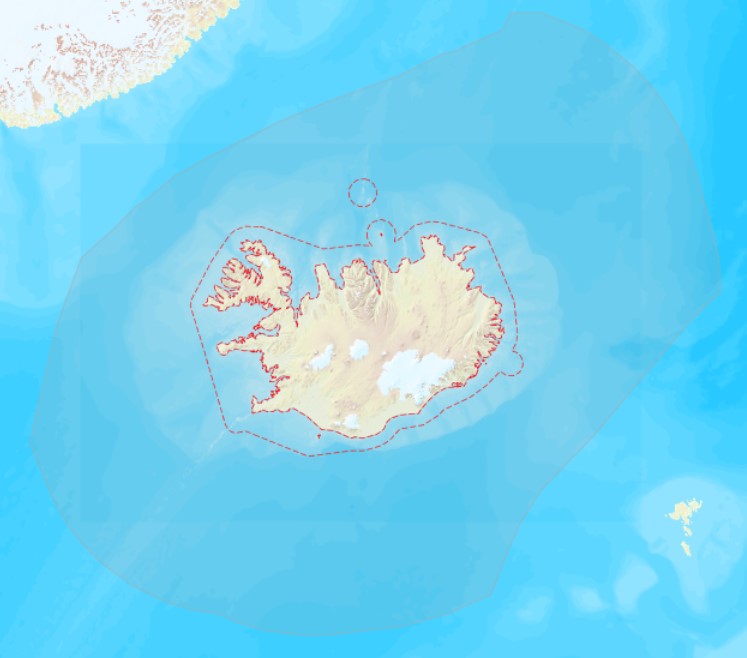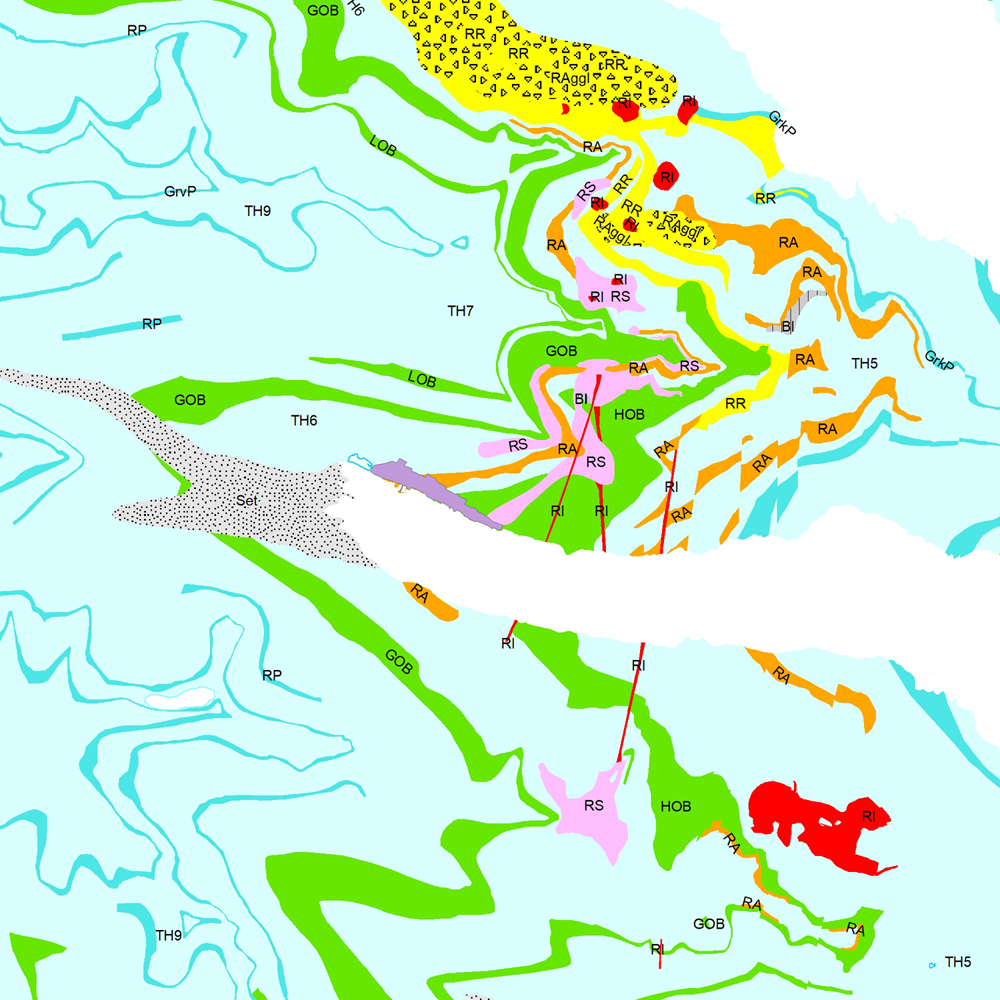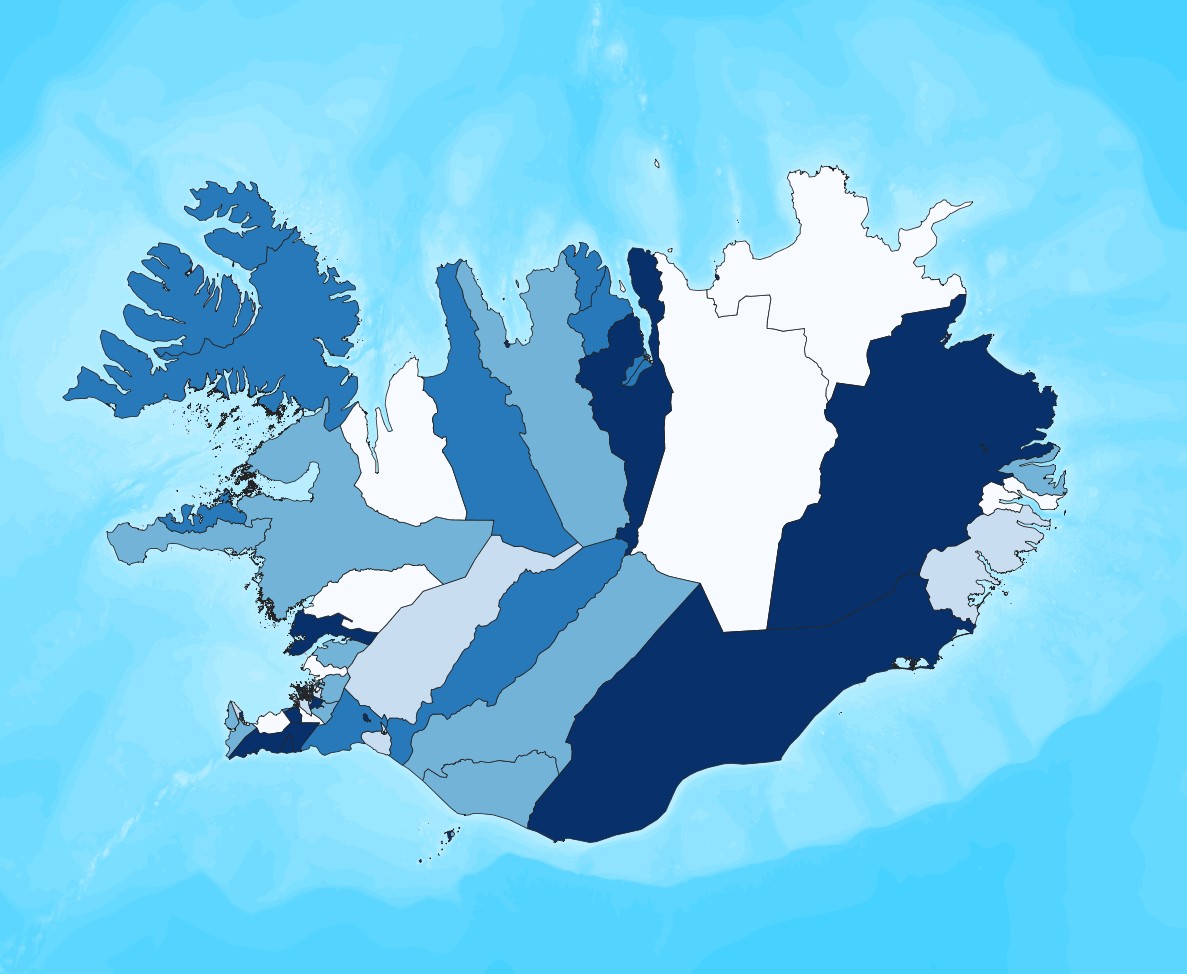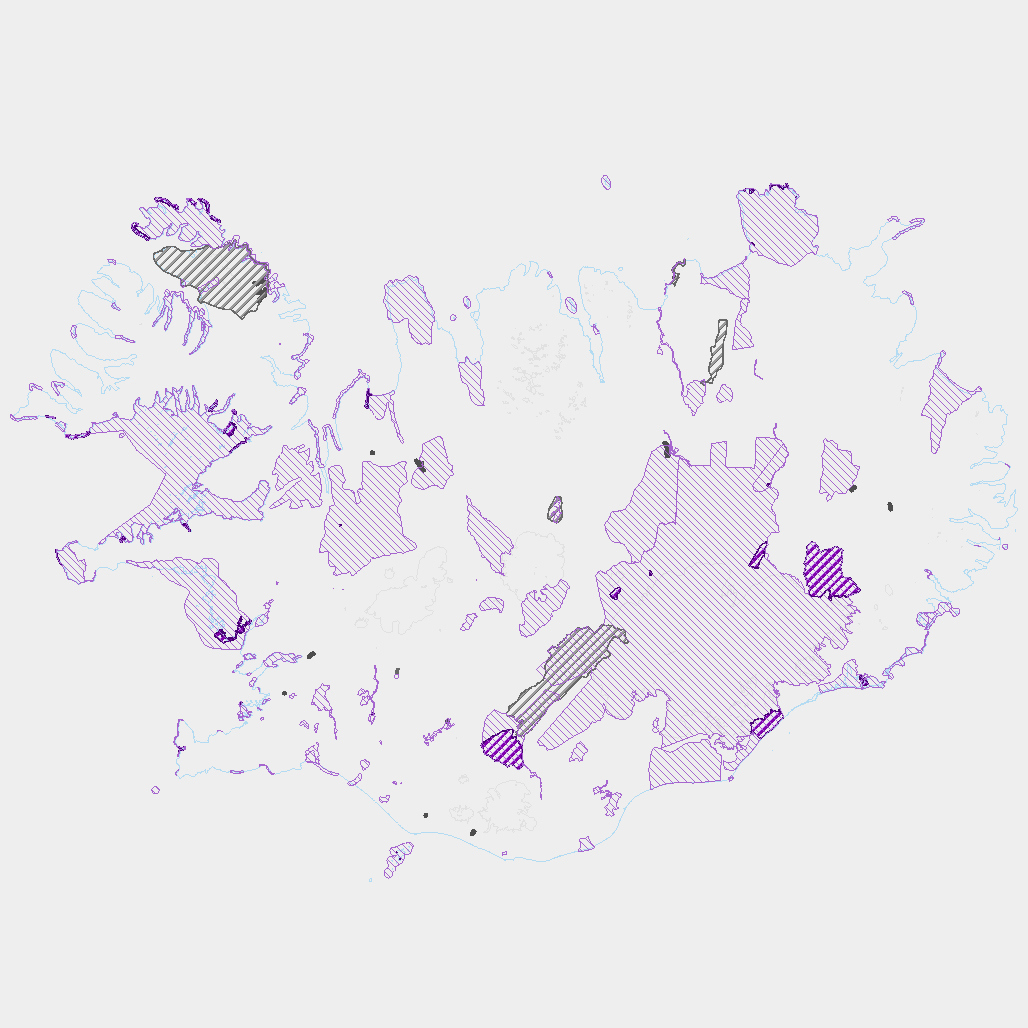asNeeded
Type of resources
Available actions
Topics
INSPIRE themes
Keywords
Contact for the resource
Provided by
Years
Formats
Representation types
Update frequencies
status
Scale
Resolution
-

Landhelgi Íslands er skilgreind í lögum nr. 41/1979 með síðari breytingum frá 15. október 2021. Heiti laganna er Lög um landhelgi, aðlægt belti, efnahagslögsögu og landgrunn. Í lögunum eru skilgreiningar og útskýringar á aðlægu belti, efnahagslögsögu og landgrunni Íslands: https://www.althingi.is/lagas/nuna/1979041.html Landhelgi Íslands skal afmörkuð af línu sem alls staðar er 12 sjómílur frá grunnlínu. Grunnlína er sett fram sem lína en einnig punktar. Línan er dregin milli punktanna. Aðlægt belti er svæði utan landhelgi (línur). Efnahagslögsaga Íslands er svæði utan landhelgi (línur). Vinsamlega hafið samband við Landhelgisgæslu Íslands vegna nánari upplýsinga.
-

Þekja (layer) j100v_austurland_berggrunnur_1utg_fl: Gögn sem sýnir bergrunn Austurlands. [Data showing the bedrock geology of Eastern Iceland.] Flákalag með bergrunn Austurlands. Flákarnir sýna mismunandi gerðir storkubergs ásamt sethulu. Gögn eru flokkuð eftir ÍST120:2012 staðlinum, nema þrjá fitjueigindir: myndunKodi = Heiti myndunarinnar (skammstöfun) myndunIS = Heiti myndunarinnar (á íslenskuc) myndunEN = Heiti myndunarinnart (á ensku) Nýr kóði fyrir fitjueigindi 'Tegund storkubergs' (tegStorkubergs): shra = samsett hraun, dbas = Dílabasalt, dobas = Díla- og olívínbasalt, and = Andesít. [Polygone layer of the bedrock geology of Eastern Iceland. The polygones show different classes of intrusive and extrusive rocks and the sediment cover. The data follows the ÍST120:2012 data standard with the three additional feature attributes: myndunKodi = Lithostratigraphic unit (abbreviation) myndunIS = Lithostratigraphic unit (in Icelandic) myndunEN = Lithostratigraphic unit (in English) New codes for feature attribute 'Tegund storkubergs' (tegStorkubergs) are: shra = composit lava, dbas = porphyritic lava, dobas = porphyritic and olivine basalt, and = andesite.]
-

Gögin upplýsingar um strok og tjón sem hefur átt sér stað sjókvíeldi. Hægt er að sjá hvar strokið átti sér stað, hvenær og hverskonar fiskur strauk. Einnig er hægt að sjá hvort hjón var á búnaði eða gat á kví. Fyrir frekari upplýsingar er bent á að hafa samband við matvælastofnun.
-

The European Urban Atlas provides reliable, inter-comparable, high-resolution land use and land cover data for 800 Functional Urban Area (FUA) for the 2012 reference year in EEA39 countries. The spatial data can be downloaded together with a map for each FUA covered and a report with the metadata for the respective area. Additional information (product description, mapping guidance and class description) can be found here: https://land.copernicus.eu/user-corner/technical-library/urban-atlas-2012-mapping-guide-new Commission Directorate-General for Regional and Urban Policy and the Directorate-General for Enterprise and Industry in the frame of the EU Copernicus programme, with the support of the European Space Agency and the European Environment Agency.
-

Útlínur dregnar á grundvelli háupplausnarlandlíkana sem mæld voru með leysimælitækum úr flugvél á árunum 2007 til 2013.
-

Ýmsar tölulegar upplýsingar úr manntali Hagstofunnar frá 2011, settar fram á smásvæðaskiptingu Hagstofunnar. Vinsamlega hafið samband við Hagstofuna vegna nánari upplýsinga.
-

Þekja ni_tillogur_a_Bhluta_allt_fl: Tillögur að svæðum á framkvæmdaáætlun (B-hluta) náttúruminjaskrár út frá verndun vistgerða, fugla, sela, jarðminja og fossa. Innan stærri verndarsvæða voru í sumum tilfellum afmörkuð smærri svæði sem draga fram forgangsvistgerðir eða fuglategundir sem eru ekki einkennandi fyrir heildarsvæðið. Mörk eru ekki alltaf nákvæmlega skilgreind. Náttúruminjaskrá skiptist í þrjá hluta sem auðkenndir eru sem A, B og C-hluti. B-hluti er framkvæmdaáætlun náttúruminjaskrár þ.e. skrá yfir þær náttúruminjar sem Alþingi hefur ákveðið að setja í forgang um friðlýsingu eða friðun á næstu fimm árum. Í lögunum er lögð áhersla á að byggja upp skipulegt net verndarsvæða til að stuðla að vernd líffræðilegrar fjölbreytni, jarðbreytileika og fjölbreytni landslags. Náttúrufræðistofnun Íslands gerir tillögur um minjar sem ástæða þykir til að setja á framkvæmdaáætlun, þ.e. B-hluta. Að loknu því vali felur ráðherra Umhverfisstofnun að meta nauðsynlegar verndarráðstafanir á svæðum sem til greina kemur að setja á framkvæmdaáætlun og kostnað við þær. Í því ferli koma fram ýmsir aðrir hagsmunir sem geta haft áhrif á endanlegt val svæða en eru sem slíkir ekki grunnþættir í vali á svæðum til að viðhalda ákjósanlegri verndarstöðu vistgerða, vistkerfa eða tegunda. Að lokum mun Umhverfis-, orku- og loftslagsráðuneytið í samráði við ráðgjafanefnd leggja fram þingsályktunartillögu um verndun svæða. Tillögurnar eru enn í úrvinnslu hjá Umhverfisstofnun og umhverfis-, orku- og loftslagsráðherra (staða 23. febrúar 2022). Afmörkun svæða í tillögum Náttúrufræðistofnunar er ekki alltaf nákvæmlega skilgreind og getur tekið breytingum við áframhaldandi undirbúning framkvæmdaáætlunar.
-

Línurnar sýna friðunarsvæði, þar sem eldi laxfiska (fam. salmonidae) í sjókvíum er óheimilt skv. auglýsingu nr. 460/2004.
-

Smásvæði Ísland er dreifbýlt land, en þéttbýlt á höfuðborgarsvæðinu. Hefðbundin skipting landsins í landsvæði og sveitarfélög býður ekki upp á samanburðarhæf svæði hvað varðar hagskýrslugerð. Hagstofan hefur því aukið við flokkunarkerfi fyrir hagskýrslusvæði með því að bæta við smásvæðum sem hafa að meðaltali 1.700 til 1.800 íbúa. Smásvæðin mynda fimmta stigið í flokkunarkerfi, með því að hluta talningarsvæðin frekar niður. Alls eru smásvæðin 206 með rúmlega 1.700 manns meðalíbúafjölda, og íbúafjöldanum haldið á bilinu 900 til 3.500 manns, en sem næst meðaltalinu. Þrepin í flokkunarkerfinu eru þessi. 1 - Ísland allt 2 - Tvö hagskýrslusvæði (NUTS3) – höfuðborgarsvæði og landsbyggð 3 - Fjórir landshlutar – tveir á höfuðborgarsvæðinu og tveir á landsbyggðinni 4 - Alls 42 talningarsvæði – 13 í Reykjavík, 11 í Nágrenni Reykjavíkur, 9 á Suðursvæði og 9 á Norðursvæði. 5 - Alls 206 smásvæði – hverju talningarsvæði skipt upp í 2 til 11 smásvæði. Með smásvæðaskiptingunni verður mögulegt að birta ítarlegar hagskýrslur fyrir smærri svæði en áður án þess að þurfa að sleppa úr svæðum eða eyða tölum vegna fámennis. Smásvæðin eru skilgreind vegna þarfa manntalsins 2021, en einnig hefur verið gerð sérstök útgáfa fyrir manntalið 2011, með 183 svæðum sem fylgja að mestu sömu mörkum. Smásvæðaflokkunin var unnin í samstarfi við Byggðastofnun, með fjárhagslegum stuðningi frá Evrópusambandinu. Þá naut Hagstofan aðstoðar Náttúrufræðistofnun ásamt afnotum af gögnum frá Landmælingum og Mílu ehf. -------------------------------------------------------------------------------------------------------------------------------------- Minor Statistical Output Areas (MSOA) Due to the sparsely populated country and huge differences in the population sizes of the administrative units, Statistics Iceland has added a new small area level to the hierarchical regional classification in preparation for the 2021 Census. The new level is labeled as Minor Statistical Output Areas (MSOA). There are in total 206 MSOA defined, with an average population in the range 1,700 to 1,800 persons and no area having less population than 900 persons, and no area exceeding 3,500. There are 5 steps in the Regional classification: 1 - Iceland 2 - Two NUTS3 Statistical regions 3 - Four Statistical Regions – 2 in the capital region and 2 in the rural areas 4 - Forty-two (42) Statistical Output Areas (SOA) – 42 areas, 13 in Reykjavik, 11 in the Reykjavik surrounding areas, 9 in the South Region, and 9 in the North region 5 - Two hundred and six (206) Minor Statistical Output Areas (MSOA) –each SOA partitioned further into 2 to 11 MSOA. With the help of the Minor Statistical Output Areas Statistics Iceland is able to publish detailed statistics for smaller areas than previously possible without skipping areas or deleting data due to disclosure concerns. While the MSOA are defined in preparation for the 2021 Census of the Population and Housing, a special version has been developed for classifying data in the 2011 Census, with 183 MSOA, which are but for 23 areas identical to the 2021 version. The MSOA were developed with financial aid from the European Commission, in cooperation with the Icelandic Regional Development Institution and the assistance of the Institute of Nature Research and Míla ehf.
-

Vefþjónustan inniheldur upplýsingar um hættusvæði, jafnáhættulínur og mörk hættumetins svæðis fyrir nokkra þéttbýliskjarna. Nánari upplýsingar fást á vef VÍ (https://www.vedur.is/ofanflod/haettumat). Útgefið hættumatskort gildir ef misræmi er á milli þess og vefþjónustunnar.
 Lýsigagnagátt
Lýsigagnagátt